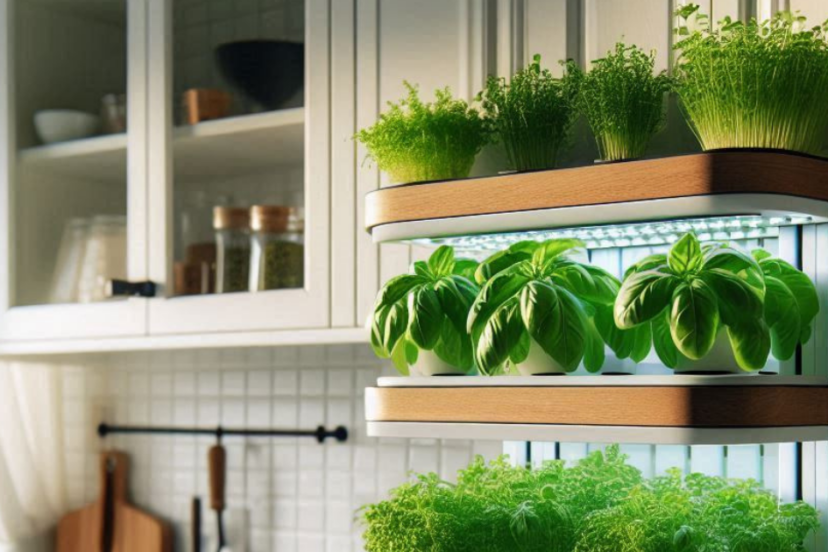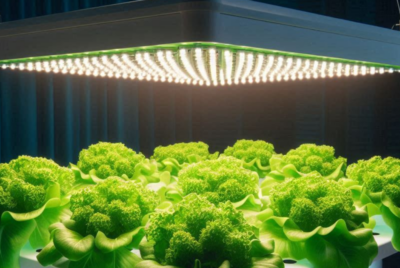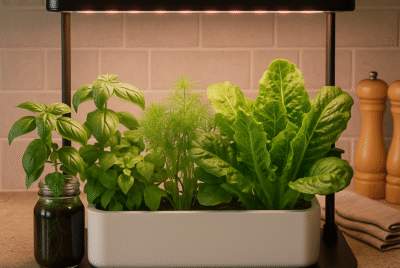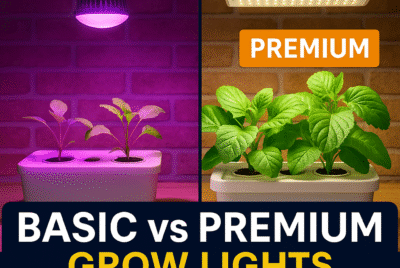Hydroponics is revolutionizing the way we grow plants. Whether you’re an experienced gardener or a beginner looking for a new challenge, hydroponics offers an innovative solution to growing crops efficiently without soil. With this guide, we’ll explore the essentials of hydroponics, its various systems, equipment, and provide tips and product recommendations to help you succeed in your hydroponic gardening journey.
Introduction
What is General Hydroponics?
At its core, general hydroponics refers to a method of growing plants using mineral nutrient solutions in water, without the use of soil. Plants are typically grown with their roots submerged in a nutrient-rich solution or supported by an inert medium like perlite or hydroponic clay pebbles, which provide stability while allowing roots to absorb essential nutrients. Unlike traditional gardening, hydroponics offers a more controlled environment that allows for faster plant growth and higher yields, particularly in urban areas where space is limited.
Why Hydroponics is Gaining Popularity
The popularity of hydroponics has surged in recent years due to its ability to overcome several challenges associated with traditional gardening. Urbanization, limited space, and climate change have driven many to seek alternative growing methods, and hydroponics is an ideal solution. With hydroponics, you can grow food indoors or in small spaces, and it requires less water than traditional farming. Furthermore, it allows for year-round gardening, ensuring a constant supply of fresh produce.
A Quick Overview of the Benefits
Some key benefits of general hydroponics include:
•Faster Growth: With the right conditions, plants can grow up to 50% faster than traditional soil-based gardening.
•Water Efficiency: Hydroponics uses up to 90% less water than conventional soil gardening.
•Space Efficiency: Ideal for small spaces or urban environments, many hydroponic systems, like the hydroponic tower garden, are designed to maximize vertical space.
•No Pests or Weeds: Hydroponics is a controlled environment, meaning fewer pest problems and no weeds to worry about.
•Fewer Chemicals: Growing without soil reduces the need for pesticides and herbicides, making it a cleaner, greener option.
Understanding Hydroponics
The Science Behind Hydroponics
Hydroponics works by providing plants with all the nutrients they need directly through the water they absorb. Plants typically rely on soil to extract these nutrients, but hydroponics bypasses the soil and introduces nutrients directly into the water. This process can lead to faster growth and more efficient nutrient absorption.
There are several types of nutrient solutions used in hydroponics. The most common ones include liquid solutions that contain essential elements such as nitrogen, phosphorus, potassium, calcium, magnesium, and sulfur. These elements are vital for plant growth and development.
Different Types of Hydroponic Systems
When it comes to hydroponics, there are several systems to choose from. Each has its unique characteristics, and choosing the right system depends on your space, budget, and the type of plants you want to grow.
Wick System
The wick system is one of the simplest hydroponic methods. A wick is used to draw the nutrient solution up to the plant roots. This system doesn’t require pumps or air stones, making it an affordable and low-maintenance choice. It’s ideal for small-scale gardening, such as growing herbs or small vegetables.
Deep Water Culture (DWC)
In
DWC hydroponics, plant roots are submerged in a nutrient-rich solution with oxygen supplied by air stones or pumps. This system is popular for growing larger plants like tomatoes, lettuce, and herbs. It’s a very efficient system, as plants have direct access to nutrients and oxygen, resulting in faster growth.
Ebb and Flow Hydroponics
Also known as the flood and drain system, the
ebb and flow hydroponics method involves periodically flooding the plant roots with nutrient solution and then draining it. This system is excellent for growing a wide variety of plants and works well in larger setups or commercial applications. However, it requires a pump and is more complex to set up than simpler systems like the wick system.
Nutrient Film Technique (NFT)
The
NFT hydroponic system involves a thin film of nutrient solution flowing over the roots of plants. The system uses a sloped tray, and the solution continuously flows through, providing nutrients to the plants. NFT is ideal for growing leafy greens and herbs, and it’s an efficient system with relatively low water usage.
Choosing the Right Hydroponics System for You
Factors to Consider
Before diving into hydroponics, it’s essential to consider a few key factors to determine which system will work best for your needs.
Space and Budget
If you have limited space, systems like the hydroponic tower garden or a hydroponic tower DIY setup could be great choices. These vertical systems maximize space and are easy to set up in smaller areas like apartments or patios. On the other hand, if you’re looking to grow larger quantities of food, a larger system such as DWC or ebb and flow may be necessary. Also, consider the initial setup costs, as some systems can be expensive to install.
Maintenance and Complexity
Some hydroponic systems are relatively low-maintenance, like the Kratky method, where plants are grown in a shallow container of nutrient solution without pumps. Others, like ebb and flow systems, require more effort in terms of setting up pumps, timers, and ensuring proper drainage. Choose a system that matches your level of experience and commitment.
What Plants You Want to Grow
Not all plants are suited to every hydroponic system. For example, if you want to grow hydroponic potatoes, you’ll need a more advanced system that allows for root expansion. Leafy greens like lettuce and spinach, on the other hand, thrive in systems like deep water culture (DWC hydroponics) or aeroponics.
General Hydroponics Equipment
Essential Hydroponics Tools
Setting up a successful hydroponic garden requires specific equipment to ensure that your plants get the proper nutrients and environment they need to thrive.
Grow Lights
If you’re growing indoors or in a space with limited natural light, grow lights are essential. LED grow lights are energy-efficient and provide the right spectrum of light for plant growth. Look for full-spectrum LED lights that offer both blue and red wavelengths, which are vital for photosynthesis.
Pumps and Air Stones
Pumps are necessary for circulating the nutrient solution in systems like DWC and ebb and flow. Similarly, air stones help oxygenate the water, ensuring that plant roots receive the oxygen they need for optimal growth. A good quality pump and air stone setup will prevent root rot and promote faster growth.
pH and EC Meters
Maintaining the correct pH and electrical conductivity (EC) levels in your nutrient solution is vital for plant health. A pH meter helps ensure that the water is in the optimal range for nutrient uptake, while an EC meter allows you to measure the nutrient concentration to ensure your plants are getting the right amount.
Popular General Hydroponics Kits
For those new to hydroponics or anyone looking for an all-in-one solution, there are several excellent hydroponic kits available that provide everything you need to get started.
General Hydroponics WaterFarm
The General Hydroponics WaterFarm is an iconic hydroponic system that’s perfect for small to medium-sized gardens. It’s an ebb and flow system that’s simple to set up and maintain, making it ideal for beginners.
General Hydroponics AeroGarden
The General Hydroponics AeroGarden is an indoor hydroponic system that’s easy to use and doesn’t require soil. It’s perfect for growing herbs and small vegetables, and it comes with built-in LED lights to support growth.
Overview of Top-Rated Systems
1. AeroGarden: User-friendly and ideal for beginners.
2. Hydrofarm: Versatile and suitable for a wide range of plants.
3. AC Infinity Advance Grow System: Premium option with advanced features.
4. Tower Garden: Vertical system perfect for small spaces.
5. Click and Grow: Automated and easy to use.
Top Recommended Products
When setting up your hydroponic garden, you’ll need the right equipment to ensure success. Here are five top-rated products on Amazon to help you get started:
1.AeroGarden Bounty Elite – This is a great system for beginners and experts alike. It includes built-in grow lights and an easy-to-use nutrient system.
2.General Hydroponics Flora Series – A top-rated nutrient solution designed for all hydroponic systems, including DWC and ebb and flow.
3.Hydrofarm Active Aqua Air Pump – A high-quality air pump that provides efficient oxygenation for your plants’ roots.
4.Hydroponic Clay Pebbles – Essential for providing stable support for plants in systems like DWC and flood and drain systems.
5.AquaSprouts Garden – A combination of aquaponics and hydroponics, this is perfect for those looking to integrate fish into their garden.
Tips and Tricks for Successful Hydroponic Growing
Managing pH and Nutrients
Maintaining the right balance of nutrients and pH is crucial in hydroponics. Here are five tips for managing both:
1.Regularly Check pH Levels: Make sure the pH of your nutrient solution stays within the optimal range for your plants (usually between 5.5 and 6.5).
2.Adjust Nutrient Concentration: Keep an eye on the electrical conductivity (EC) of your solution to ensure your plants are getting enough nutrients.
3.Change the Solution Regularly: Over time, nutrient levels can drop. Change the nutrient solution every two weeks to ensure your plants have access to fresh nutrients
4.Use Quality Hydroponic Nutrients: Invest in high-quality, balanced hydroponic nutrients to ensure your plants receive all essential nutrients in the right proportions.
5.Monitor Nutrient Deficiencies: Keep an eye out for signs of nutrient deficiencies, such as yellowing leaves or stunted growth, and adjust your nutrient solution accordingly.
Common Problems and How to Avoid Them
Hydroponics is an efficient and rewarding way to grow plants, but like any gardening method, there are common challenges that can arise. Here are five common problems and how to address them:
1.Root Rot: One of the most common issues in hydroponics is root rot, caused by poor oxygenation. Ensure that your system has adequate air stones and pumps to keep oxygen flowing to the roots.
2.Nutrient Imbalance: Too much or too little nutrients can harm your plants. Always measure your nutrient solution carefully and maintain the appropriate EC and pH levels.
3.Pest Infestations: While hydroponic systems are less prone to pests than traditional soil gardens, they can still occur. Use beneficial insects or organic pest control methods to keep pests in check.
4.Algae Growth: Algae can develop in hydroponic systems, particularly if light reaches the nutrient solution. To prevent this, keep your system covered and avoid exposing the nutrient solution to too much light.
5.Water Temperature: Inconsistent water temperatures can stress plants and hinder nutrient absorption. Keep the water temperature between 65°F and 75°F for optimal growth.
Best Plants for Hydroponics
Not all plants are suited for hydroponic growing, so it’s essential to choose varieties that thrive in soilless environments. Here are five plants that grow well in hydroponic systems:
1.Lettuce: Lettuce is one of the easiest and most popular hydroponic crops. It grows quickly and thrives in systems like DWC hydroponics and NFT.
2.Tomatoes: Tomatoes are perfect for hydroponics as they thrive in a controlled environment. Use larger systems like DWC or ebb and flow for optimal results.
3.Herbs: Herbs like basil, mint, and cilantro are well-suited to hydroponics and can grow quickly in smaller systems like the hydroponic tower garden.
4.Strawberries: Hydroponics is an excellent method for growing strawberries, especially in vertical systems like the hydroponic tower DIY.
5.Peppers: Peppers, including bell peppers and chili varieties, can thrive in hydroponic systems, especially when given plenty of space to grow.
Conclusion
Hydroponics is a revolutionary method of growing plants that can provide many benefits, from faster growth to higher yields and lower water usage. By understanding the science behind hydroponics and choosing the right system and equipment, you can enjoy the satisfaction of growing your own fresh produce, whether in a small apartment or on a larger scale.
With numerous systems like DWC hydroponics, ebb and flow, and Kratky hydroponics, there’s a method for every type of grower, from beginners to experts. By managing your system’s pH and nutrients, troubleshooting common problems, and selecting the best plants for hydroponics, you’ll be well on your way to hydroponic success. Whether you’re using hydroponic clay pebbles, or a vertical hydroponic tower garden, the possibilities are endless.
Embrace the future of gardening and start your hydroponic journey today!
FAQs
1. What is the easiest hydroponic system for beginners?
The wick system is generally considered the easiest hydroponic system for beginners. It’s a simple, low-maintenance setup that doesn’t require pumps or air stones.
2. Can I grow all plants hydroponically?
While many plants can be grown hydroponically, leafy greens, herbs, and strawberries are particularly well-suited for hydroponic systems. Root crops like hydroponic potatoes require more complex systems, but they can be grown with the right setup.
3. How often do I need to check the pH in my hydroponic system?
It’s recommended to check the pH of your hydroponic system at least once a week, though you may need to check it more often if you notice issues with your plants.
4. What are the best nutrients for hydroponics?
The best nutrients for hydroponics are those that provide a balanced mix of nitrogen, phosphorus, potassium, calcium, magnesium, and sulfur. Brands like General Hydroponics Flora Series are popular for their complete nutrient formulas.
5. How long does it take for plants to grow in hydroponics?
Hydroponic plants typically grow 25-50% faster than those grown in soil. For example, lettuce may take only 3-4 weeks to mature in hydroponics, while tomatoes may take 2-3 months, depending on the system.
*We may earn a commission from purchases made through our links, at no cost to you. This does not affect our product recommendations. Please see our disclosure to learn more.




